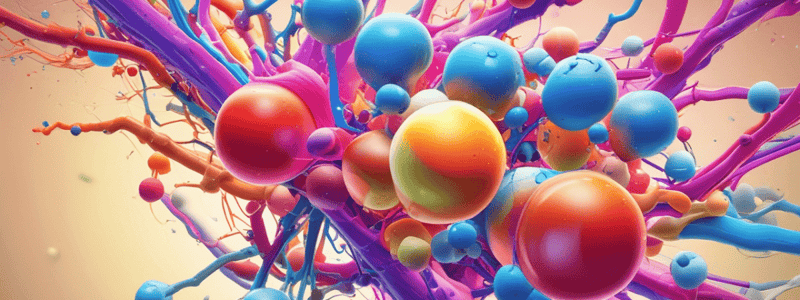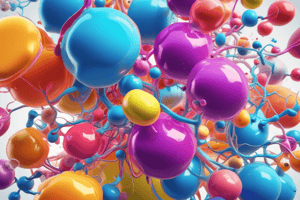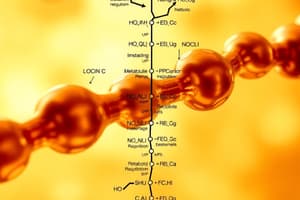Podcast
Questions and Answers
What is the key difference between anabolic and catabolic reactions?
What is the key difference between anabolic and catabolic reactions?
- Anabolic reactions release energy
- Anabolic reactions decrease entropy
- Anabolic reactions are spontaneous
- Anabolic reactions synthesize molecules with more bonds (correct)
Which concept describes the chemical energy available to do work?
Which concept describes the chemical energy available to do work?
- Free energy (G) (correct)
- Activation energy
- Entropy
- Enthalpy
What does a negative ∆G value for a reaction indicate?
What does a negative ∆G value for a reaction indicate?
- The reaction is non-spontaneous
- The reaction has high entropy
- The reaction is exergonic (correct)
- The reaction requires energy
Which term refers to the network of anabolic and catabolic reactions in a cell?
Which term refers to the network of anabolic and catabolic reactions in a cell?
Why do enzymes reduce the activation energy of a reaction?
Why do enzymes reduce the activation energy of a reaction?
Which of the following statements about allosteric regulation of enzymes is correct?
Which of the following statements about allosteric regulation of enzymes is correct?
Which of the following statements accurately describes negative feedback regulation in metabolic pathways?
Which of the following statements accurately describes negative feedback regulation in metabolic pathways?
What is the primary mechanism by which positive $\Delta G$ reactions are accomplished in cells?
What is the primary mechanism by which positive $\Delta G$ reactions are accomplished in cells?
Which of the following statements about ATP is correct in the context of reaction coupling?
Which of the following statements about ATP is correct in the context of reaction coupling?
Which of the following statements accurately describes the role of NADH (or NADPH) in metabolism?
Which of the following statements accurately describes the role of NADH (or NADPH) in metabolism?
Which of the following statements accurately describes the first law of thermodynamics?
Which of the following statements accurately describes the first law of thermodynamics?
Which of the following statements accurately describes the relationship between enthalpy, entropy, and free energy in reactions?
Which of the following statements accurately describes the relationship between enthalpy, entropy, and free energy in reactions?
Which of the following statements accurately compares anabolic and catabolic reactions in terms of free energy change?
Which of the following statements accurately compares anabolic and catabolic reactions in terms of free energy change?
Which of the following statements accurately describes the role of enzymes in negative $\Delta G$ reactions?
Which of the following statements accurately describes the role of enzymes in negative $\Delta G$ reactions?
Which of the following statements accurately describes the process of oxidation and reduction in the context of electron transfer?
Which of the following statements accurately describes the process of oxidation and reduction in the context of electron transfer?
What is the primary role of allosteric effectors in enzyme regulation?
What is the primary role of allosteric effectors in enzyme regulation?
In a negative feedback loop in metabolic pathways, what inhibits an enzyme at the beginning of a pathway?
In a negative feedback loop in metabolic pathways, what inhibits an enzyme at the beginning of a pathway?
Which energy carrier captures high-energy electrons from organic molecules in metabolism?
Which energy carrier captures high-energy electrons from organic molecules in metabolism?
What is the primary function of NADH (or NADPH) in cellular processes?
What is the primary function of NADH (or NADPH) in cellular processes?
In reaction coupling, how are positive ∆G reactions made to work in living cells?
In reaction coupling, how are positive ∆G reactions made to work in living cells?
Which reaction is used to accomplish positive ∆G reactions through reaction coupling?
Which reaction is used to accomplish positive ∆G reactions through reaction coupling?
What type of reaction combines a positive ∆G reaction with a negative ∆G reaction to yield a net negative ∆G?
What type of reaction combines a positive ∆G reaction with a negative ∆G reaction to yield a net negative ∆G?
What is the primary function of enzymes in negative ∆G reactions?
What is the primary function of enzymes in negative ∆G reactions?
$NAD^+$ is reduced to $NADH$ during which process?
$NAD^+$ is reduced to $NADH$ during which process?
Which of the following best describes the relationship between anabolic and catabolic reactions in a cell's metabolism?
Which of the following best describes the relationship between anabolic and catabolic reactions in a cell's metabolism?
According to the Second Law of Thermodynamics, which of the following statements is true about the relationship between energy and entropy in chemical reactions?
According to the Second Law of Thermodynamics, which of the following statements is true about the relationship between energy and entropy in chemical reactions?
What is the relationship between $\Delta G$, enthalpy, and entropy in chemical reactions?
What is the relationship between $\Delta G$, enthalpy, and entropy in chemical reactions?
How do enzymes influence the activation energy of a chemical reaction?
How do enzymes influence the activation energy of a chemical reaction?
Which of the following best describes the mechanism by which enzymes interact with their substrates?
Which of the following best describes the mechanism by which enzymes interact with their substrates?
What is the primary function of ATP in the context of metabolic reactions?
What is the primary function of ATP in the context of metabolic reactions?
How do negative feedback mechanisms regulate metabolic pathways?
How do negative feedback mechanisms regulate metabolic pathways?
What is the role of NADH (or NADPH) in cellular metabolism?
What is the role of NADH (or NADPH) in cellular metabolism?
Which term refers to the overall network of anabolic and catabolic reactions that make up a cell's metabolism?
Which term refers to the overall network of anabolic and catabolic reactions that make up a cell's metabolism?
Flashcards are hidden until you start studying




